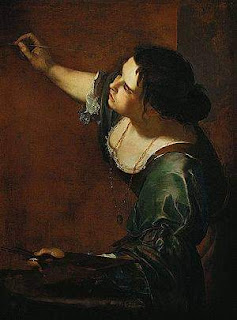Artemisia Gentileschi
Artemisia Gentileschi
Artemisia Gentileschi was one of the greatest female artists of the baroque age.
A brilliant follower of the Caravaggio, she utilized his technique of chiaroscuro in her works. Modern critics have called her paintings the “real successors to Caravaggio with a muscular personality all their own.” However, as with most female artists she faced blatant sexism as well as other barriers despite her obvious talent.
A brilliant follower of the Caravaggio, she utilized his technique of chiaroscuro in her works. Modern critics have called her paintings the “real successors to Caravaggio with a muscular personality all their own.” However, as with most female artists she faced blatant sexism as well as other barriers despite her obvious talent.
Born in Rome on July 8, 1593, Artemisia was the eldest child of Tuscan painter Orazio Gentileschi and his wife Prudentia Montone. As a child, she was drawn to her father’s workshop and showed more artistic talent than her brothers, a fact that did not make traditionalists happy. Many of her paintings were confused by patrons as being done by her father. Her mother died when she was twelve, which left her mainly in the company of men. Her father struck up a friendship with numerous artists in Rome including Michelangelo Merisi da Caravaggio. Both Artemisia and her father’s style was heavily influenced by Caravaggio.
As she got older, Artemisia applied to the Academy of Art, but was refused entry because of her gender. Her father supported her talent and arranged for her to have a private teacher. He hired Agostino Tassi, with whom he was decorating the vaults of the Casino della Rose. Tassi must have seemed like a good choice, however, this was the biggest mistake he could have made. Unbeknownst to Artemisia and her father, Tassi was, to put it succinctly, a scum bag. According to Mary Garrard’s book Artemisia Gentileschi, Tassi was known to have raped both his wife and sister-in-law. His wife was missing and presumed dead, and most people believed Tassi had something to do with her disappearance. In short, he was the last person anyone would want in close contact with their seventeen year old daughter.
Tassi quickly became obsessed with the young Artemisia and spied on her and hired men to watch her around the clock. He became insanely jealous at the thought of her with another man, and went out of his way to prevent her from marrying someone else. Finally, he made his move convincing an older friend of Artemisia’s to let him into the house. He trapped her in her bedroom and raped her. According to testimony at the later trial, Artemisia fought back by scratching his face and even stabbing him with a knife, but he was too strong. Upon finding she was a virgin, he promised to marry her. Great. Who wouldn’t want that guy as a husband? Because she was afraid he would not marry her and she would be shamed, Artemisia continued a sexual relationship with Tassi. However, Tassi refused to marry her. There was a little matter of his first wife and the fact he was a scum.
When Artemisia’s father found out, he pressed charges against Tassi for rape. Tassi denied it, and claimed Artemisia was having sex with at least five other men. He also claimed Artemisia was writing erotic letters to many other men. Small problem. Artemisia could not read or write. He claimed his presence at her house was to safeguard her honor. Tassi’s testimony was so ridiculous the judge had to stop the trial several times to ask him to stop lying. Unbelievably though, his testimony was taken as is. Artemisia was subjected to torture to prove hers. First she was given a gynecological exam by midwifes in front of the judge to see if her virginity had been taken recently. If that wasn’t enough, she was subjected to the sibille. These were ropes tied around her fingers and tightened like thumbscrews. Let’s let this sink in. The rape victim was tortured to ensure the veracity of her testimony. As the ropes were wound around her fingers, Artemisia screamed at Tassi, “This is the ring you gave me and these are your promises!” As the ropes were tightened, she repeated over and over, “It is true, it is true, it is true, it is true.” Tassi was convicted and ordered to be banished from Rome for a year. However, he was a favorite of Pope Innocent X. The sentence didn’t stick.
Unsurprisingly, Artemisia needed a change of scene and was married to Pieratonio Stiattesi from Florence and moved there. In 1618, she had a daughter with him named Prudentia after her mother. In Florence she was the first woman accepted into the Accademia delle Arti del Disegno, and enjoyed much success. Since she was female, Artemisia had the decided advantage of being able to use live female nude models. This was not allowed to male artists of the day. She was taken up by Granduke Cosimo II de’Medici and rubbed elbows with Galileo Galilei and Michelangelo Buonarroti the younger, the nephew of that Michelangelo. She often painted Biblical themes, and one she returned to often was that of Judith beheading Holofernes. Unlike other artists, her Judith has taken control of the situation and is actively harming Holofernes. The second version of this theme is currently in the Uffizi Gallery of Florence and many critics believe this was a version of revenge. I wonder if Holofernes ever looked like Tassi. Also, her time with Galileo must have rubbed off as the blood spatter in this painting is in accordance with his discovery of the parabolic path of projectiles.
She returned to Rome in 1621 after her marriage disintegrated and cast about ways to support herself and her daughter. She bounced about from Rome to Venice to Naples and then her work caught the eye of King Charles I of England. In 1638, she joined her father in London at the English court remaining there even after her father’s death. When civil war broke out in England, it is unknown what she did, however, evidence points to her being in Naples by 1649. It is unknown when exactly she died or what happened to her daughter, who was also a painter. Some have theorized Artemisia died in a plague which swept Naples in 1656. However, art historian Charles Moffat believes Artemisia may have committed suicide, which would explain why her cause of death was not recorded.
She leaves behind a legacy of bold work, which transcends time and gender.





Comments
Post a Comment